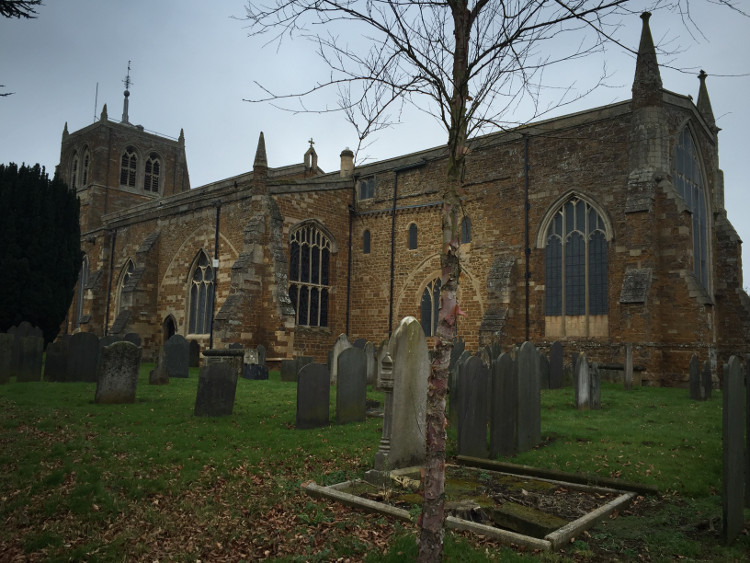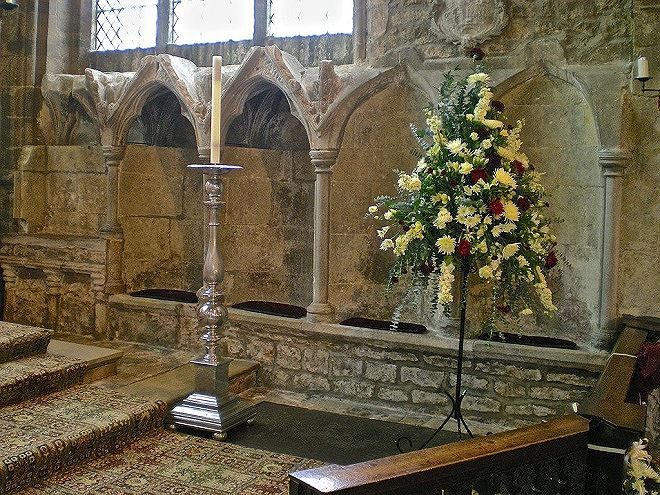Mysterious church crypt 2,500 sets of remains
Gliding along the narrow, humid, narrow stone staircase beneath the Holy Trinity church in Northamptonshire, England, will reach the bone vault, also known as the Rothwell chapel, with about 2,500 remains. The basement is considered one of the two medieval chapels in England still holding the 'original' human remains.
Although it has been dating for hundreds of years, many remains seem to be intact. Skull bones are lined up neatly on wooden shelves. Behind the corner of the skull are many pieces of bone from other parts, stacked on top of each other.

Outside Rothwell Chapel.
History from the Middle Ages
In 1950, the Holy Trinity Church was placed on the UK's list of the most special structures. In addition to being considered the longest church in England, it is also known as the place where the 700-year-old mysterious ' human bone base ' lies underground.
Thousands of bones in the tomb are thought to be the remains of pilgrims and prayers, not the bones of patients or soldiers as people have thought for a long time.
It is known that in the Middle Ages, hundreds of human bone bunkers scattered in rural England. Archaeologists have discovered more than 50 medieval tombs dating from the 13th to the 15th century, located in a church complex, parish church, monastery and hospital across England.
After burial of the ancestors, the flesh flew away and left the remains, people were careful to bring the remains to these basements as a common graveyard for convenient visits and prayers. Prayer will help the deceased soon to escape to the sacred path.

In 1700, the basement was first discovered.
Over the centuries, the number of these tombs has decreased sharply due to being destroyed or forgotten. Now, the bone bunker or the Rothwell Chapel under the Holy Trinity Church, Northamptonshire is said to be one of two medieval warehouses in England that still contain the bones of the ancients. According to archaeologists, the basement dates from the 13th century and is the resting place of about 2,500 anonymous people, of which 1,500 are relatively intact, but only 800 skulls.
Since the discovery of the catacombs, its research has continued and has since raised many different theories. Typically, in the 1860s, Paul Cypher (the pseudonym of a local doctor and pastor) published a document, suggesting that chapels like Rothwell were built in some other churches of the Middle Ages. neck to place human bones when digging a new tomb.
Before that, in 1700, the basement was discovered for the first time when a grave digger fell into a wide basement sprawling with skeletons, shocking everyone. Since then, people have heard a lot of unknown stories about a black hole full of human bones. So far these stories have become the traditional culture of the locality.
Just a form of 'common graveyard'?
Recently, the University of Sheffield research project Rothwell Charnel Chapel opened to find out more about this "bone bone tunnel". Why are there so many bodies? Who are they? Why do they die? How did the cellar play a role in medieval times? Is it simply a common graveyard used for other purposes? .
'There have been so many false rumors around this hundred-year-old human bone tunnel and my aim is to find out the real reason why this cellar was built' , Mrs. Jenny Crangle, an archaeologist said.
Previously, many people thought, the tomb was like a 'garbage zone', meaning that it contained unimportant remains such as patients suffering from disease or soldiers killed in the battle of Naseby that broke out in 1645. But some argue that skeletons show no signs of injury proving they are victims of the plague.
As a result, scientific researchers from the University of Sheffield's archeology have found the answer. The bones in the 13th-century tomb are of pilgrims who come here to pray and the villagers. There are also remains to be taken to chapels to pray for peace and escape.
Crangle, along with Sheffield University scientists, has been studying this grave system for five years continuously, using modern scientific techniques to analyze 800 samples of human bones. Scientists believe that people have moved bones from many graveyards to tombs as a form of burial.
'The bones in the catacomb above are not soldiers because they include the bones of women and men. Furthermore, the bones in the crypt are not the remains of the patients. No one wants to dig graves, move the bodies of infected people , 'Mrs. Crangle explained, ' The marks on the bones, which people once thought were scars when fighting, actually appeared after people I'm dead. '
Many rumors say that in the tunnel there is only the backbone and skull, but in fact there are many complete human skeletons all parts. Now researchers are hoping they will classify the age, gender and hometown of the remains.
Location is of international importance
Hypothesis has always been a hypothesis and the mysteries of Rothwell will remain the subject of future research by scientists. That why there are thousands of human skeletons but so many incomplete sets? Where have they been taken? Why are so many skulls missing? . Again, that's a tough question no one has ever found.

The image of the Rothwell bones bone.
Researchers at Sheffield University have identified nearly 60 bone storage points across the UK. But nowhere is the hundred-year-old human skeleton well preserved in Rothwell.
Lizzy Craig Atkins, an archaeologist who is also a researcher at Sheffield University, said: ' The Rothwell Chapel (bone bunker) is an internationally important place. Such leftover chapels are very rare in England. It contains the ideal archaeological resources for researchers to use to enhance our understanding of medieval corpses. '
'Hundreds of years have passed, but the skeletons that really make the generation of today impressed. This could be said to be an important place in the middle ages, a sacred place , 'Lizzy said.
Currently, researchers at the University of Sheffield have recreated bone bunkers so anyone can visit this mysterious place without feeling scared. The area is always lit and everyone is allowed to enter. Anyone with a high sense of steel and curiosity, the Rothwell Chapel is the ideal place to admire the mysterious skeletons that exist for seven centuries. This also becomes a place for local people to pray for the souls of the dead.
- The church decorated with more than 40,000 skeletons
- The mysterious church built by 'angels' in Africa
- Mysterious infant body buried with the bishop of Sweden
- 2,000-year-old remains inlaid with jewels and gold of two saints in Germany
- The discovery of the remains resembles the astronomer Copernicus
- Promotion of Alfred Emperor's core test
- Mexico studied 30 sets of ancient remains
- The 5,000-year-old fist couple remains in Russia
- Restoring the face of a woman who was supposed to be the wife of Jesus
- The remains of the medieval woman are over 2m high in Poland
- Ancient remains reveal our 'fishman' ancestors
- Mysterious remains of women belong to another human species
 Discovered an ancient centipede fossil 99 million years old
Discovered an ancient centipede fossil 99 million years old Discovered bat-like dinosaurs in China
Discovered bat-like dinosaurs in China Discovered a 200-year-old bronze cannon of the coast
Discovered a 200-year-old bronze cannon of the coast Discover 305 million-year-old spider fossils
Discover 305 million-year-old spider fossils